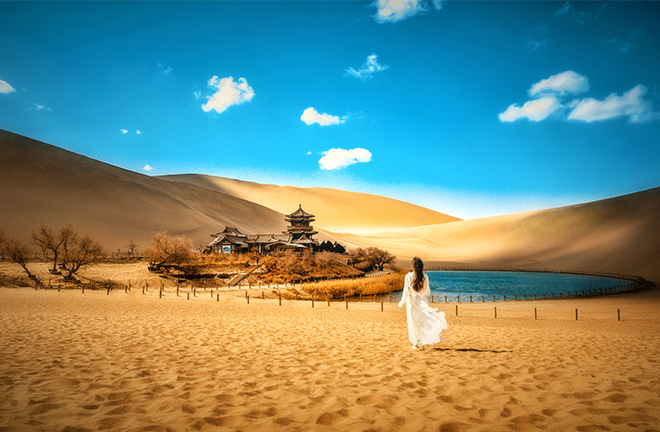Dunhuang research advances modern Chinese civilization

Dunhuang examplifies the passing on of the cultural heritage. Photo: TUCHONG
Dunhuang, a shining pearl in the long river of world history, is of exemplary significance to Chinese civilization and even global civilization.
Perseverance
Throughout history, successive dynasties have recognized the importance of Dunhuang as a national gateway, a pivotal transport hub, and a center of commerce. Each dynasty implemented various measures to manage Dunhuang, including economic incentives, political coordination, and cultural tolerance.
Before the reign of Emperor Wudi (156–87 BCE) of the Han Dynasty, Hexi [west of the Huanghe River] and the Western Regions centered around Dunhuang were already crucial nodes along the East-West routes of exchanges. In the era of underdeveloped transportation, the arduous efforts of Chinese ancestors to facilitate East-West exchanges and integration can easily be imagined. Generation after generation traversed the Silk Roads, covering daily distances of 30, 50, or even 70 li. How long did it take for these efforts to form the expansive Silk Roads spanning tens of thousand li? Moreover, traversing deserts, highlands, and rivers—if not for their perseverance, their struggles would have been fruitless. Yet, through successive generations, Chinese ancestors achieved mutual exchanges and integration of Eastern and Western civilizations—a feat deserving immense admiration!
Craftsmanship
The ancient people of Dunhuang practiced various forms of spiritual beliefs, with cave construction for good wishes becoming important activities in their daily lives. It is precisely due to the spirit of craftsmanship and the pursuit of perfection that the charm of the Dunhuang Grottoes has been preserved and passed down for thousands of years.
Dunhuang studies primarily encompasses two major branches: the study of scriptures unearthed from the Sutra Cave and the study of Dunhuang grotto art. The discovery of the Dunhuang Sutra Cave made Dunhuang studies internationally prominent overnight. However, even without the discovery of the cave and its manuscripts, the artistic value of the works within the Dunhuang Grottoes cannot be ignored. Such magnificent and splendid grotto art forms a treasury. The creators of these amazing masterpieces are mostly unknown, their names lost to history with little information preserved. Nevertheless, one undeniable fact remains: they were all descendants of the ancestors of the past dynasties on Chinese land and inheritors of the spirit of craftsmanship of the Chinese nation.
Scientific spirit
Since its inception, Dunhuang studies have been an internationally recognized field of scholarship, with scholars from countries such as the United Kingdom, France, and Russia achieving notable accomplishments. In response, Chinese scholars have strived not to lag behind, but to excel. From the initial efforts of Mr. Luo Zhenyu and Mr. Wang Guowei in collecting, organizing, and publishing the literature, to the continuous emergence of summative works, and the launch of seminal works in important fields, over the span of more than 120 years, the ranks of Chinese scholars studying Dunhuang have grown steadily, yielding a series of important achievements. Particularly noteworthy is the cultivation of young talent, as successive generations of mid-career and young researchers are emerging as the future leaders and driving forces in Dunhuang studies. Today, Chinese scholars boast fruitful research achievements across various domains of Dunhuang studies.
In modern times, successive generations of Dunhuang scholars have steadfastly persevered in the desert, devoted themselves to the task, pioneered new frontiers, and pushed forward with an enterprising spirit. They have continuously dug into the philosophical ideas, humanistic spirit, and values behind Dunhuang culture and historical sites, which has not only promoted the prosperity and development of Dunhuang studies, but also promoted the creative transformation and innovative development of fine traditional Chinese culture.
In short, Dunhuang culture crystallizes long-term exchanges and integration among various civilizations. The Silk Roads, with Dunhuang at its center, represent not only trade routes spanning the Eurasian continent, but also paths of inter-civilizational exchanges and dialogue that promoted friendly exchanges between Eurasian countries and China.
Liu Quanbo is a professor from the Institute of Dunhuang Studies at Lanzhou University.
Edited by ZHAO YUAN
